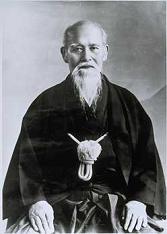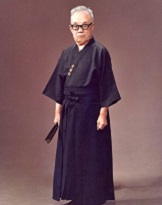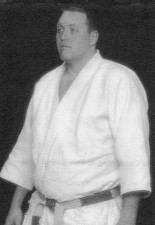

Aikido was founded by Ueshiba Morihei (1883-1969), based mainly on Daito-ryu Aikijujutsu as taught by Takeda Sokaku, with elements of Yoshin-ryu body movement and Yagyu-ryu footwork. The unique philosophical aspects of Aikido come from Ueshiba sensei's involvement in the Omoto Kyo religion, a modern Shinto sect, which promotes "the achievement of personal virtue as a step to universal harmony."
Ueshiba sensei studied the following arts:
Daito-ryu is said to have originated as a family art of the Aizu clan, passed to Ueshiba's teacher Takeda Sokaku (1859-1943) via his grandfather Takeda Soemon (1758-1853), then referred to as "Aiki In-Yo-Ho". The name "Daito-ryu" is not known prior to Takeda Sokaku, and is generally regarded to be based on oshikiuchi (the Aizu fighting system used inside a castle), Sumo, and Ono-ha Itto-ryu kenjutsu (largely a dueling system). Interestingly, his adoptive grandfather Kanenori Dengoro Kurokochi (d.1868) practiced "Shin Muso Muraku-ryu Iaijutsu" which was the family style of the Aizu clan (along with Muso-ryu Jujutsu).
Takeda Sokaku is said to have studied the following arts under these teachers:
|
 |
| Takeda Sokaku defined aiki in the following way:
"The secret of aiki is to overpower the opponent mentally at a glance and to win without fighting."
This principle (similar to saya no uchi) is also a foundation of Ueshiba sensei's Aikido.
The Dojo is now home to a probationary study group for Daito-ryu Aikijujutsu, following the lineage of Horikawa Kodo. |
 |

Tomiki Kenji was a Judo godan and national competitor when he met Ueshiba sensei. He became a lifelong student, Aikikai instructor, and was the first person awarded 8th degree in Aikido. Tomiki sensei studied during the pre-war Daito-ryu period, and his approach to constructing an Aikido syllabus included principles from Judo and his research in the Kodokan archives. Tomiki Aikido includes robust open-hand atemi ("striking" throws) and combines the aiki of DAITO-RYU with the KITO-RYU tradition of paired responses, wherein resisting one technique always creates an alternative.
Tomiki sensei developed an Aikido "alphabet" consisting of transitional releases (vowels) and finishing techniques (consonants). With this, Tomiki sensei found he could duplicate all the "10,000" techniques of Ueshiba sensei's Aikido. Tomiki sensei used this concept to create a system of formal katas to train fundamentals and techniques in a consistent and organized way.
In addition to fundamentals and a free practice system (randori), Tomiki and his kohai Ohba Hideo developed a series of koryu no kata, classical techniques drawn from the original Daito-ryu that Ueshiba taught, plus advanced concepts and weapons work. Our dojo works to practice these kata using internal principles from Daito-ryu.

In 1981, three top students of Tomiki Kenji formed a new Aikido organization. Miyake Tsunako is the senior living student of Tomiki sensei, and acted as the sponsor and technical advisor. Karl Geis was the first foreigner to achieve 6 dan in Aikido, and served as President. Inoue Takeshi was principle uke for Tomiki sensei during development of the Koryu no kata. The Fugakukai was founded to preserve and develop the self-defense aspects of Tomiki sensei's Aikido, using formal katas and non-competitive randori to train responses, experiment and test the system. Geis sensei refined the katas to include circular movements and additional variations, and added a set of randori chain techniques to teach transitions and spontaneous reaction. The hallmarks are continual evasion, throwing exclusively by body motion, and avoiding arbitrary (planned, not responsive) movements. In 1996, Geis sensei renamed his system to "Karl Geis Ryu" and began referring to his style as "Kihara".

In 2008, Nick Lowry formed the KazeUta (Windsong) Budokai. This group functions as a community of martial artists committed to fellowship, personal growth, and development of quality martial arts. Ranks earned at Denton Aikido are recognized under this association.
In 1991, the Dallas Aikido Club was started by Jack Bieler to teach the Tomiki style of Aikido. The Denton club was started in 1997. In 2009, the Denton Aikido Club joined the Windsong Budokai and fostered relationships with the American Tomiki Aikido Association and other groups promoting this lineage of Aikido. This has coincided with a rededication to practicing vigorous, principle-based, and correct budo.
Aikido must work in real self-defense situations and survive testing. Our Aikido is based on physical principles of movement, posture, timing, instability and off-balance. Mind and Body and Spirit are an inseparable continuum; training one conditions the others.
Automatic response: Self defense has to be automatic. Building a subconscious response system requires internally consistent movements. In other words, you must always react the same way regardless of the stimulus. This means always reacting with Aikido - evade, attach, follow, lead. It means you can't afford to think before acting. Thinking is slow and unreliable; the brain is best used to coach, observe and strategize. Mind and body must be trained to allow the physics of Aikido to occur naturally, unimpeded.
Nothing works: We assume failure. Every technique has counterparts that appear when the former fails, so the attacker has a devil's choice between two catastrophic failures. Also, "nothing" works -- using no power yields the greatest results, and keeps you safest. Defend against a technique by accomodating its power, but move to dissipate its effect.
Resistance is futile: Aikido techniques work better if the attacker resists, since they use the attacker's own strength. If a technique is overcome, it wasn't the right one at that moment of reality, and you proceed to the next alternative. You can't always overpower, but you can underpower. If YOU resist, you have given an opening to your opponent.
Transcend victory and defeat: The ego is afraid and greedy. Its two demons are Fear of losing (or dying) and Desire to defeat your opponent or do a particular technique. The only survivable path is to detach from self. Focus on principles, on feeling, on coordinating -- never on the outcome. Practice remaining calm under stress to immunize yourself against adrenaline (fight or flight). Remember to never add strength of your own choosing; a throw is an extreme off-balance of uke's choice.
Understand Yin and Yang: There are techniques, and there is technique. Without the latter, the former are in vain. Employ the pairs of opposites: rise/fall (KITO), tension/compression, hineri/gaeshi, left/right, irimi/tenkan, following/leading, empty/full, ebb/flow, hard/soft (GOJU). Capture the rhythm of the attack with your eyes, before the attack begins. Accomodate and control their rhythm and your own in conjunction. Go with the flow, and direct the flow. There are no rules.
Spontaneous technique: Aikido is self-regulating. To get the best natural off-balance, float your feet rather than planning steps. Match movement, don't accelerate, never choose. If you can't predict your technique, neither can your opponent. There are infinite ways to be attacked, so you cannot formulate individual answers. As in mathematics, a small number of consistent principles can apply to an infinite range of situations.
Attack the attack: This is Ai-uchi -- disrupting the attack by invading, pressuring, pre-empting the initiative. Defense does not always mean waiting to be attacked. Give them problems to deal with, make them forget their intent, put them on the defensive. Attack the eyes to control the center and take the advantage. You will either create an opening, or end it quickly.
Fast is slow; slow is fast: Moving fast requires preparation; quick motion is relaxed, adaptive and immediate. Real power is slow and inexorable like water. Fast commits to arbitrary action; slow attaches and matches, slowing down the attacker. Deal with the center, using gravity as the great equalizer. Speed IS strength; Slowness is softness; we have only one set of muscles that creates either strength or speed depending on if there is resistance. Also, practice slowly for correctness and safety. Like a musician, start by drilling scales and build quickness as the body becomes trained.
Attention: This is zanshin, constant vigilance. Achieve mutual victory by preempting the attack with awareness and calm, fearless attitude. Don't let yourself be taken advantage of, even when it masquerades as friendly horseplay. This is why it is said that budo starts and ends with REI: respect.
On Jujutsu and its Modernization by Tomiki Kenji
Competitive Aikido by Tomiki Kenji
Interview with Tomiki Kenji by Aiki News
A Common Sense Look At Aikido by Kuroiwa Yoshio
Ritualized Combat essay by Darren Laur
The Origin of the Fugakukai by Karl Geis
Why Purity In the Martial Arts? by Karl Geis
Interview with Karl Geis by David Russell